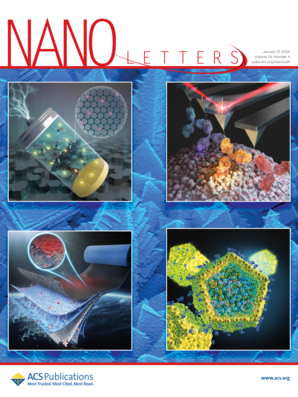Energy-Efficient Stochastic Signal Manipulation in Superparamagnetic Tunnel Junctions via Voltage-Controlled Exchange Coupling
IF 9.6
1区 材料科学
Q1 CHEMISTRY, MULTIDISCIPLINARY
引用次数: 0
Abstract
Superparamagnetic tunnel junctions (sMTJs) are emerging as promising components for stochastic units in neuromorphic computing owing to their tunable random switching behavior. Conventional MTJ control methods, such as spin-transfer torque (STT) and spin–orbit torque (SOT), often require substantial power. Here, we introduce the voltage-controlled exchange coupling (VCEC) mechanism, enabling the switching between antiparallel and parallel states in sMTJs with an ultralow power consumption of only 40 nW, approximately 2 orders of magnitude lower than conventional STT-based sMTJs. This mechanism yields a sigmoid-shaped output response, making it ideally suited to neuromorphic computing applications. Furthermore, we validate the feasibility of integrating VCEC with SOT current control, offering an additional dimension for magnetic state manipulation. This work marks the first practical demonstration of the VCEC effect in sMTJs, highlighting its potential as a low-power control solution for probabilistic bits in advanced computing systems.

基于压控交换耦合的超顺磁隧道结节能随机信号处理
超顺磁隧道结(sMTJs)由于其可调节的随机开关行为,成为神经形态计算中随机单元的重要组成部分。传统的MTJ控制方法,如自旋传递扭矩(STT)和自旋轨道扭矩(SOT),往往需要大量的功率。在这里,我们引入了电压控制交换耦合(VCEC)机制,使sMTJs中的反并行和并行状态之间的切换具有超低功耗,仅为40 nW,比传统的基于stt的sMTJs低约2个数量级。这种机制产生s形输出响应,使其非常适合神经形态计算应用。此外,我们验证了将VCEC与SOT电流控制集成的可行性,为磁态操作提供了额外的维度。这项工作标志着VCEC效应在sMTJs中的首次实际演示,突出了其作为先进计算系统中概率位的低功耗控制解决方案的潜力。
本文章由计算机程序翻译,如有差异,请以英文原文为准。
求助全文
约1分钟内获得全文
求助全文
来源期刊

Nano Letters
工程技术-材料科学:综合
CiteScore
16.80
自引率
2.80%
发文量
1182
审稿时长
1.4 months
期刊介绍:
Nano Letters serves as a dynamic platform for promptly disseminating original results in fundamental, applied, and emerging research across all facets of nanoscience and nanotechnology. A pivotal criterion for inclusion within Nano Letters is the convergence of at least two different areas or disciplines, ensuring a rich interdisciplinary scope. The journal is dedicated to fostering exploration in diverse areas, including:
- Experimental and theoretical findings on physical, chemical, and biological phenomena at the nanoscale
- Synthesis, characterization, and processing of organic, inorganic, polymer, and hybrid nanomaterials through physical, chemical, and biological methodologies
- Modeling and simulation of synthetic, assembly, and interaction processes
- Realization of integrated nanostructures and nano-engineered devices exhibiting advanced performance
- Applications of nanoscale materials in living and environmental systems
Nano Letters is committed to advancing and showcasing groundbreaking research that intersects various domains, fostering innovation and collaboration in the ever-evolving field of nanoscience and nanotechnology.
 求助内容:
求助内容: 应助结果提醒方式:
应助结果提醒方式:


